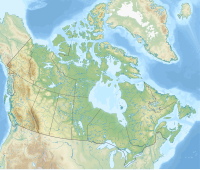|
Caldron Peak
Caldron Peak is a 2,911-metre (9,551 ft) mountain peak of the Waputik Range, located in Alberta, Canada.[1][2] It is prominently visible from the Peyto Lake Overlook in Banff National Park. It was named after Caldron Lake which is 3 km (1.9 mi) from its summit. GeologyLike other mountains in Banff Park, Caldron Peak is composed of sedimentary rock laid down during the Precambrian to Jurassic periods.[4] Formed in shallow seas, this sedimentary rock was pushed east and over the top of younger rock during the Laramide orogeny.[5] ClimateBased on the Köppen climate classification, Caldron Peak is located in a subarctic climate with cold, snowy winters, and mild summers.[6] Temperatures can drop below -20 C with wind chill factors below -30 C. Precipitation runoff from Caldron Peak Peak drains into the Mistaya River which is a tributary of the North Saskatchewan River. References
|
||||||||||||||||||||||||||||||


